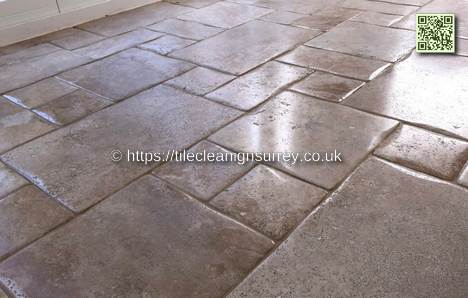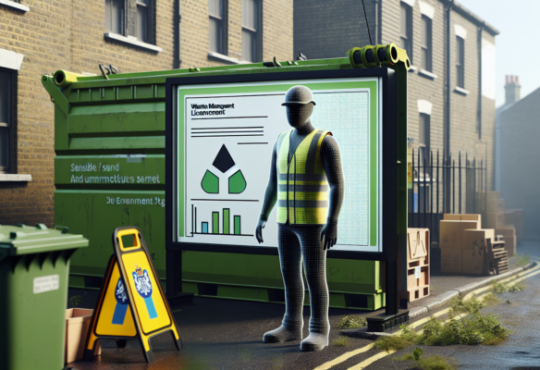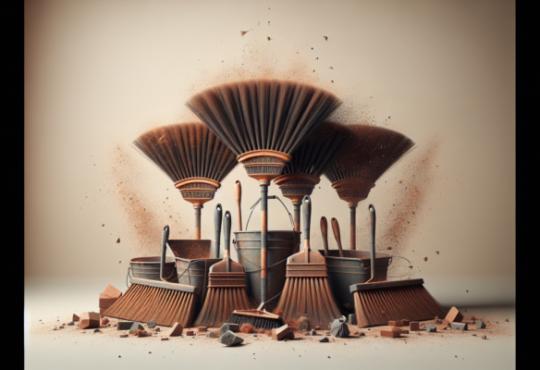
Reviving Travertine Floors in Chessington, Surrey
This case study showcases the restoration of travertine tiles in high-traffic areas of a property in Chessington, Surrey. As the years passed, the once-beautiful travertine had lost its luster, becoming dull, stained, and worn. To restore its original elegance, we undertook a comprehensive project that included deep cleaning, filling natural holes, and applying a protective sealant. The result was a beautifully revitalized, low-maintenance floor that regained its natural charm and received long-lasting protection for future durability.
Travertine Floor Cleaning In Chessington – Key Points
- Thorough Cleaning is Crucial: A rotary scrubbing machine, heavy-duty travertine cleaners, and hot water pressurized rinse equipment remove ingrained soil that regular mopping can’t tackle.
- Filling Holes Enhances Appearance and Durability: Addressing natural holes in the travertine improves its look and prevents future damage, ensuring the stone’s longevity.
- Sealing Simplifies Maintenance: A properly applied sealer acts as a protective barrier, making future cleaning easier and preventing stains from setting in.
- Consistent Maintenance is Essential: A regular maintenance routine, including periodic resealing, keeps the travertine pristine and preserves its beauty for years.
Client Background:
This project focused on restoring travertine tiles in a Chessington home, where the kitchen, hallway, and w/c floors had suffered significant wear over the years. The homeowner sought a solution to bring back the natural beauty of the travertine while ensuring the floors would be easy to maintain and durable enough to withstand daily use. The restoration process involved deep cleaning, filling natural holes, and applying a protective sealant to achieve a clean, resilient surface that highlights the rich colors of the travertine.
 Project Background:
Project Background:
The travertine tiles, admired for their natural beauty and durability, had been in place for over a decade. Over time, the tiles lost their smooth finish, with soil accumulating in the pits and voids. The grout was discoloured, diminishing the floor’s overall look. The project involved deep cleaning the tiles, filling the natural holes, and applying a protective sealer to restore the floor’s appearance and enhance its long-term resilience.
Challenges Encountered During the Project
- Deeply Embedded Dirt: Years of foot traffic had caused dirt to become ingrained in the natural pits and voids of the travertine, making it difficult to clean with standard methods.
- Natural Holes: Travertine tiles’ inherent holes and gaps trap the dirt and add to the floor’s worn appearance.
- Stained Grout: Over time, the grout between the tiles had become heavily stained, further diminishing the floor’s visual appeal.
- High Traffic Areas: The constant use of these spaces required a restoration approach that effectively revitalized the floor while minimizing disruption to the household.
Solution and Process:
Step 1: Assessment and Planning
The initial assessment identified the level of soiling and wear on the travertine tiles. Based on these findings, a plan was crafted to remove the ingrained dirt, fill the natural holes, and apply a protective sealer to restore the tiles and improve their durability.
Step 2: Cleaning Process
We prepared the work area by removing small pieces of furniture and clearing loose debris with brushing and vacuuming. After applying a diluted travertine cleaner and letting it soak for ten minutes, we used a rotary scrubbing machine with a medium-grade brush to remove the surface soil. We used hot-water rinse and capture equipment to tackle the dirt trapped in the holes and pits, effectively lifting the remaining soils and restoring the travertine’s clean surface.
Step 3: Filling Natural Holes
Step 4: Sealing the Floor
We applied a hybrid satin finish sealer with a roller, creating a mid-sheen look. This sealant formed a protective barrier against stains and dirt, making the floor easier to maintain. We ensured full coverage and a consistent finish during the sealing process.
Project Timeline:
We completed the project in two days, from assessment to final touches.
Project Results:
We restored the travertine to its original finish by removing ingrained soil and stains, revealing the natural colours of the tiles. The client expressed her delight with the results, commenting that the floor “looked as good as new”. The protective sealer now keeps the travertine low-maintenance and durable, preserving its beauty and functionality for the long term. This project turned a dull, worn floor into a revitalized, stunning surface.
Conclusion:
This travertine cleaning project in Chessington restored the tiles’ natural beauty, making them a durable and low-maintenance flooring solution for the homeowner. We significantly enhanced the floor’s appearance and extended its longevity through deep cleaning, precise filling, and effective sealing. This case study highlights the value of professional cleaning and maintenance for natural stone surfaces like travertine.
If your travertine floor needs cleaning or restoration, contact us today for a consultation. Our expert services will keep your natural stone surfaces beautiful and functional for years to come.
Frequently Asked Questions
How Long Does the Travertine Cleaning Process Take?
The travertine cleaning usually takes several hours, depending on the floor’s condition. Thorough cleaning techniques remove ingrained soil and prepare the tiles for sealing, which helps prolong their lifespan.
Is It Safe to Use DIY Cleaning Products on Travertine?
Homemade cleaning solutions on travertine can be risky due to potential chemical reactions that may harm the stone. For this reason, it’s safer to use pH-balanced cleaners specifically designed for natural stone to ensure effective and safe cleaning.
Can Travertine Floors Be Installed Over Existing Tile?
Yes, travertine floors can be installed over existing tiles. Proper installation requires assessing the underlying surface and potentially levelling it to ensure a stable, long-lasting finish.
What Is the Cost Range for Travertine Floor Cleaning Services?
The cost of travertine floor cleaning services typically ranges from £3 to £5 per square foot. The price varies depending on the cleaning methods, soiling, and the condition of the tiles.
How Often Should Travertine Floors Be Professionally Cleaned?
Travertine floors should be professionally cleaned every 12 to 18 months. Regular maintenance, including prompt spill management and periodic sealing, will help preserve the stone’s natural beauty and longevity.
The post Travertine Floor Cleaning In Chessington Surrey. Sponsored by: Travertine Cleaning Chessington
The Article Reviving Travertine Floors in Chessington, Surrey appeared first on https://fabritec.org
The Article Reviving Travertine Floors in Chessington, Surrey Was Found On https://limitsofstrategy.com
The Article Reviving Travertine Floors in Chessington, Surrey First Appeared ON
: https://ad4sc.com












It’s fascinating to see how proper care can breathe new life into materials like travertine, which carry both history and beauty. I often think about how the surfaces we walk on can tell a story—each scuff and mark is part of a journey. This restoration process not only revitalizes the aesthetics but also reinforces a commitment to sustainability by extending the life of existing materials.
You’ve brought up such a compelling perspective on travertine and its story. There’s something profoundly moving in the idea that every scuff and mark contributes to its narrative. It’s like a reminder that our environments are not static; they’re living histories that reflect the passage of time and the experiences of those who’ve inhabited the space.
You’ve hit the nail on the head with that observation about travertine. Every crack and blemish can feel like a conversation with the past, doesn’t it? It’s kind of like each scuff is telling a tiny story while we casually stroll over them with our coffee in hand. Imagine the tales they’d tell if they could talk—like that one time you dropped your gelato on your first date and nearly face-planted.
I completely agree about travertine holding those little stories within its imperfections. It’s fascinating how something as unassuming as a floor can capture moments from the past. Each scuff and crack does indeed feel like a whisper of history, like an unspoken witness to all kinds of life events. That visual of dropping gelato on a first date really resonates. It reminds me of how our own experiences shape the way we interact with the world.
You hit the nail on the head with that one. Floors, especially those with character like travertine, really do tell stories. It’s like they’re the quietest observers, keeping track of every spilled drink and every awkward misstep. I mean, the gelato on that first date? A classic move. Nothing says romance quite like desperately trying to wipe off sticky mess while pretending your date didn’t just witness your epic fail.
I appreciate your thoughts on travertine—there’s something really special about how everyday materials can hold emotional weight. It’s interesting to consider how floors, often overlooked, have these layered stories that connect us to our own histories and the histories of those before us.
It’s so true that each imperfection tells a story, like the little history markers of our lives, isn’t it? I often find myself pausing to admire those charming flaws, almost as if they’re whispering secrets of the people who walked that path before me. It makes me think about how we often overlook the beauty in the worn and weathered.
You really hit the nail on the head with that observation about imperfections. It’s fascinating to think how each crack or scratch carries its own story, almost like tiny artifacts from moments we can only imagine. I often find myself slowing down to appreciate those little details too, feeling a sense of connection to the past.
Your case study on travertine tile restoration resonates deeply with anyone who appreciates the beauty of natural stone. It’s fascinating how something as timeless as travertine can look so worn over time, yet, with the right care, it can be rejuvenated to its former glory!
Your appreciation for travertine really hits home. It’s fascinating to consider how we can hold a piece of nature in our homes, and travertine, with its distinct texture and rich history, exemplifies this connection perfectly. It’s a beautiful reminder of how stones have been used for centuries in architecture and design, showcasing that timelessness you mentioned.
I couldn’t agree more with your thoughts on travertine tile restoration. It really is remarkable how these natural stones can bear the marks of time and still hold such potential for beauty. There’s something about the process of restoration that feels restorative in itself, almost like it mirrors our own journeys. Just as travertine can regain its luster, we too can find ways to rejuvenate and refresh our environments as well as ourselves.
I love how you highlighted the importance of deep cleaning in restoring travertine tiles. It’s surprising how much grime can build up over time, especially in high-traffic areas. I had a similar experience with my own floors; we had to use a specialized cleaner before we realized just how dull they had gotten. It’s a whole different vibe once they’re all polished up!
It’s impressive to see how well travertine can be restored, especially in high-traffic areas where it often takes a beating. I find that many people underestimate the importance of regular maintenance, which can really prolong the life of natural stone floors like travertine. The process you’ve outlined, particularly the filling of holes, is a great reminder that it’s not just about appearances—it also contributes significantly to the stone’s durability.
You make a great point about regular maintenance with travertine. It’s fascinating how these natural stones not only bring beauty to a space but also require a bit of care to keep that beauty intact over time. I’ve noticed that when people invest in high-quality materials like travertine, they often overlook the upkeep. It’s almost like buying a beautiful plant but forgetting to water it.
You’ve hit the nail on the head! The investment in travertine—like that beautiful plant—does come with the need for a little TLC. It’s interesting how people often focus on the initial allure of natural stones, yet forget that maintenance can be a game-changer for their longevity. Regular sealing and gentle cleaning can do wonders, letting that natural beauty shine through without the stress of damage.
You make a solid point about the importance of regular maintenance for natural stone floors like travertine. It’s so easy to overlook how everyday wear can impact these beautiful surfaces. I’ve seen travertine floors in homes that haven’t received the upkeep they need, and it can be heartbreaking to witness the decline.
Restoring travertine tiles really does bring out the beauty in a space. I’ve always found that natural stone has a way of grounding a room while also adding character. Your process highlights something I think a lot of people overlook—maintenance isn’t just about cleaning; it’s about preservation.
This restoration project really highlights how even the most durable materials like travertine can require regular care to keep them looking their best. It reminds me of a similar experience I had with the tiles in my own home. When we moved in, the travertine floors were quite dull, and I initially thought a simple cleaning would suffice. It wasn’t until I had a professional service come in that I realized just how much was hidden beneath the surface.
It’s fascinating to read about the transformation of travertine tiles, especially in such high-traffic areas. I’ve always appreciated natural stone for its timeless beauty and durability, but it’s so easy to overlook the maintenance it requires, especially in busy households.
It’s great to hear your thoughts on the transformation of travertine tiles. They really do bring a unique charm to any space, don’t they? The timeless beauty of natural stone has a way of elevating the atmosphere, but like you pointed out, the maintenance aspect can often take a backseat until it becomes a pressing issue.
You’ve hit on a key point there—natural stone does bring a unique charm to a space, and it’s easy to get caught up in its aesthetic appeal. I think a lot of people don’t realize that proper maintenance can really make a difference in how travertine holds up in busy households. Regular cleaning and sealing can go a long way in keeping those tiles looking sharp and preventing issues like staining or wear.
This case study on the restoration of travertine tiles in Chessington resonates with me, particularly when considering the broader implications of preserving natural materials in our built environments. It’s fascinating how natural stone, like travertine, not only adds aesthetic value to our homes but also reflects the relationship we have with nature and our surroundings.
I completely agree with your reflections on the restoration of travertine tiles. There’s something quite profound about utilizing natural materials like stone in our homes. It makes me think about how these choices not only shape the aesthetics of our surroundings but also create a connection to the earth.
Restoring travertine tiles really highlights the intersection of beauty and practicality in home design. I’ve always found stone flooring fascinating, not only for its aesthetic appeal but also for the stories each imperfect surface can tell. Your mention of how crucial thorough cleaning is resonates with me; it’s amazing how much dirt can accumulate in high-traffic areas without us even noticing. In my own experience, I’ve learned that neglecting proper care often leads to more costly repairs down the line.